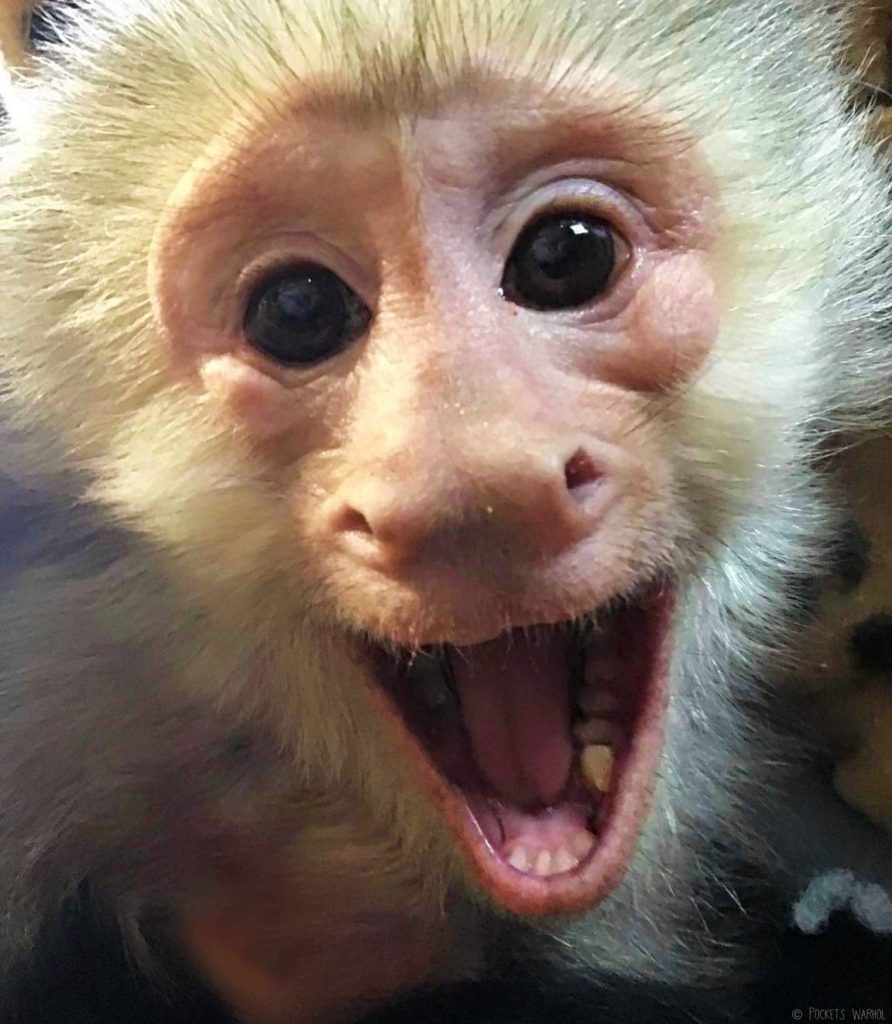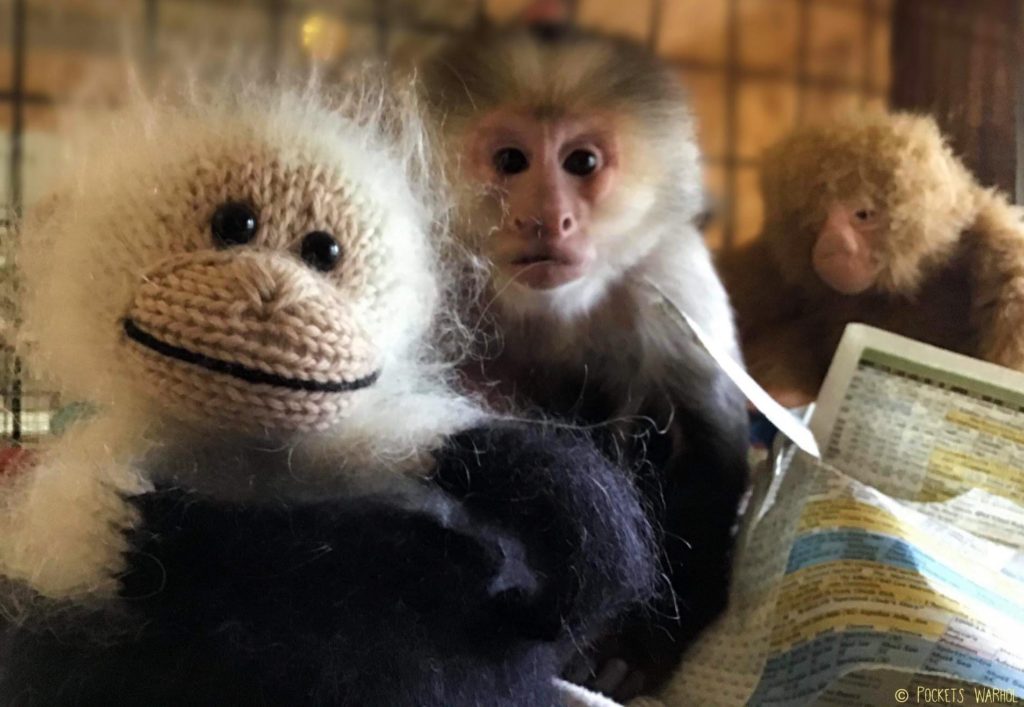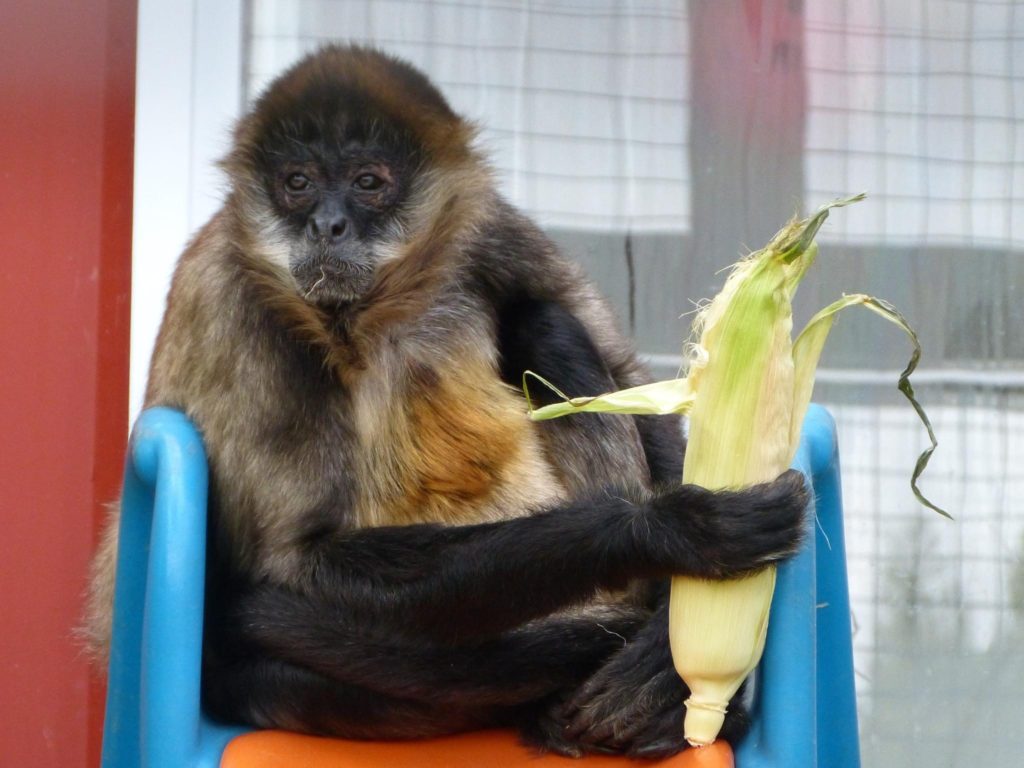
You have probably never heard of a monkey spa before, but Story Book Farm Primate Sanctuary in Sunderland, Ontario has a unique pair of assets: its charismatic monkeys and a lush, peaceful property consisting of 168 acres an hour and a half outside Toronto. I spent an Open Day with forty-odd visitors, drunk on the deep greenness of the spotless land, listening to the wind twist through long grass.
Our mission was simian, but one couldn’t help but be pulled toward the healthy farm life, chatting over cookies with volunteers who confide monkey escapades under a pretty marquee. Arriving at the property, I was met by barn cats and glimpsed a natural pond thick with frogs, who would later announce themselves into the silent, private nights. Later in the afternoon, a dozen cows wandered in a neighbouring field, parking themselves as objects of contemplation. In the evening, the monkeys fall into ancient biorhythms and a deep sleep, hard to imagine from their chirping and mischief by day.
The feel is of a primate kindergarten. Senior volunteer Rachelle Hansen checks in on the two olive baboons, to make sure that Pierre and Sweet Pea play nicely and each have a bouquet of flowers to eat. Story Book Farm has advanced the cause of baboon diplomacy by putting the two neighbours, formerly separated by bars, into a shared enclosure with a new extension funded by donations.
The monkeys welcomed their visitors with there characteristic gestures, each possessed of a unique personality, just like human beings. Despite the traumatic life stories of monkeys rescued from laboratory testing and roadside zoos, each resident of the sanctuary has made significant gains, responding to the patience of volunteers and an endless flow of tickles, treats, and gourmet fruit and vegetable salads. Spaghetti is an occasional favourite.

Pockets Warhol, overwhelmed by a crochet doppelganger. Photo: Charmaine Quinn
Pockets is an adorable white-capped Capuchin monkey whose latent artistic gifts were discovered by volunteer Charmaine Quinn, who offered him bright children’s paints and a canvas as enrichment. As it turned out, Pockets is the craziest artist since Salvador Dali. Capuchin monkeys as a species are a frequent choice in university behavioural psychology tests, due to their exceptional intelligence. Capuchins are the stars of primate economics, able to use plastic coins to exchange for treats in a range of experiments. In the wild, they carry rocks long distances to break open nuts, showing an impressive memory and skill in tool use.

————————-
As the outdoor tour moves from one enclosure to another, the resident monkey pops out on cue, each performing his own self-styled act for the guests. Pockets fixed on a friendly grandmother, choosing a favourite visitor from each tour, and it would be hard not to feel flattered. Popping back indoors through a small barn window, he began to make a huge racket, throwing his toys and smacking the walls to get everyone’s full attention. The effect was of Oscar the Grouch rustling around in his trashcan. Soon, Pockets darted back to his fans in the sunlight. In the end, Pockets only has eyes for his “Muse”, Charmaine Quinn, with whom he appeared to be communicating telepathically.
For residents of downtown Toronto, where the occasional parks are thick with cigarette butts and broken beer bottles, Story Book Farm offers an afternoon of profound peace. The lawn is ready for a family picnic in the shade, behind the large Victorian house in which the staff run the charity.
Inside, is a room which has been transformed into a gallery for the second stage of the Pockets Warhol Art Collective, wherein works by important contemporary artists (including Pockets) can be bought. New Yorker cover artist Anita Kunz curated the show, and works are available by major artists from Ralph Steadman (an American cartoonist famous for his longtime collaboration with Gonzo political writer Hunter S. Thompson of Fear and Loathing in Las Vegas) to Sue Coe (a Briton known for her graphic art promoting animal rights). Prices range from $25 to several thousand dollars, and the quality is surprising high, since Kunz called on many established, mid-career colleagues. Familiar cover cartoonists from the New Yorker mix with figurative Canadian artists. Many artists chose to produce a new, monkey-themed artwork for the show.
————————
After a brush with financial catastrophe in 2015, executive director and resident photographer Daina Liepa joined up with an anonymous donor to save the sanctuary and its furry occupants. Liepa is an amusingly glamorous character who keeps the sanctuary going from day to day, whether mucking out enclosures or running silent auctions or doing the crucial PR work for the sanctuary.
Under Liepa’s stewardship, Story Book Farm has received both local and national newspaper and TV coverage. Before devoting herself to the Sanctuary, she had a successful career in advertising. For a Sanctuary holding a little over twenty souls, it punches above its weight in the elegance of its communications. Every media announcement and notice is done just so.
Liepa has overseen the increased size of the enclosures, with their extremely expensive fencing, and the beautification of the exterior spots of the sanctuary, bringing pots of flowers for the monkeys to think about.
————————-
No one is more famous than Darwin, better known as “the IKEA monkey”, who was found in a North York IKEA parking lot wearing a shearling coat, having escaped from the car of his illegal owner. The bizarre story went viral internationally, turning into a meme on social media. After legal wrangling, Darwin was turned over to the sanctuary, where he has flourished, forming a new family with other macaques.
Dotted throughout the enclosures are large, rugged Fisher-Price toys in primary colours, large enough to stand on, with knobs and buttons with which to fiddle. Pockets has both a plastic car and a plastic pagoda. Today’s dedicated sanctuaries and zoos put great effort into enrichment, which involves keeping the animals intellectually stimulated and emotionally sound. At Story Book Farm, intricate toys, some purpose-built, are available and the monkeys work to find treats hidden in the grass and meals wrapped in bags. The sanctuary receives a treasury of toys as gifts from its many supporters, some hand-made puzzles of various sorts devised to keep the monkeys in thrall.
Some monkeys prefer nothing more than to stare at the monkey in the mirror, while others chirp out their life story to a favourite volunteer. The volunteers dance attendance on the animals, rushing around to keep them entertained. This is the crucial distinction between a sanctuary and a roadside zoo, in which monkeys are forcibly taught tricks and sealed in small cages.

Tortishell refugee from the entertainment industry, Mr. Jenkins, played Hamlet, dithering in the doorway of the barn. Sanctuary life means that primates get to choose whether to stay inside or outside, or to bathe in the summertime in plastic swimming pools.
None of the monkeys looks entirely real: their fur is so plush and their eyes so shiny that, in repose, they could be mistaken for stuffed animals. The lemurs, regarded an evil spirits in their native Madagascar, look like intergalactic visitors with their staring orange button eyes. Elderly spider monkey George throws Art Nouveau shapes, while hanging from the roof. A single bench is parked suddenly in front of a row of enclosures, from which one could drift into reverie under a complete sun, contemplating with relaxed disbelief life as lived by celebrity monkeys.